NAPO Expo 2012 Recap (Part 2) — Dine Before Battle and Have a Little Candy for Dessert
An organized army travels on its stomach, and here at Paper Doll HQ, we like to set out a smrgasbord of organizing options to help readers do battle with paper clutter. Longtime readers know that the bread and butter of paper organizing tends to come from the two bigwigs of the industry, the butcher and baker, so to speak:
&

Today, we’ll start with some innovations that each brought to the dining table at NAPO Expo 2012, and then follow up with some candy for dessert.
DIVIDE AND CONQUER
Typically, file containment falls into two categories — solo or bulky. Folders, whether 1/3- or 1/5-cut file are designed to work on their own. Sure, you can group a series of file folders in a hanging folder, or plop them in your briefcase, but they’re still distinct entities that can get separated from the group.
Conversely, accordion files tend to be bulky, and they’re designed to gather individual sheets together, even if sorted by category. They work best for specific types of projects, like collecting tax documents, but they’re not particularly attractive or efficient for presentations.
Also, most paper solutions are arrayed horizontally. Sure, the minute you pluck a file from a cabinet or a paper from the accordion file, you’re likely to turn it to display vertically…but what if you didn’t have to?

Smead’s Stackit™ Organizers offer an intriguing approach for projects and presentations. This letter size (9 3/4″ x 11 1/2″) vertically-arrayed organizer has three 5″ pockets (each of which are able to hold up to 50 sheets). The top-tabbed back panels of the first two pockets serve as dividers and are suitable for labeling. Because of the pocket styling, papers are protected from shifting, wrinkling or other damage during transport.
As with accordion files, the Stackit™ Organizer has a flap to secure documents and protect them from the elements (like a rain of coffee), and it’s even lightly scored (like the bottom of a file folder) to allow expansion. However, instead of requiring an elastic band to hold the flap in place, the cover flap neatly tucks in to the front pocket, creating a streamlined little package.
The Stackit™ is made of durable linen stock (available in black, dark blue and grey), from 40% recycled content/10% post-consumer material, with a reinforced bottom. It’s so new that it’s not yet listed at most of the major office supply stores, so keep your eyes open.

A sister product is the Stackit™ Folder in linen and textured stocks. These folders, which hold up to 100 pages, are also arrayed vertically, making them backpack-friendly. As with the Stackit™ Organizer, the pockets are 5″, safely securing the papers on three sides, preventing “floppiness” — and the folders bear the same fold-over, tuck-in flap. The front of the pocket is die-cut to hold a business card.
The linen Stackit™ Folders come in packages of five, in the same black, dark blue and grey as the Stackit™ Organizer; the textured versions come in black, red, green and light blue. Paper Doll envisions using a rainbow of Stackit™ Folders for separate elements of a larger project or for providing personalized presentation folders to each member of a board or committee.
Another divide-and-conquer advancement comes from Pendaflex. Readers may recall that Paper Doll reviewed an innovation in the NAPO Expo 2011 recap, the Pendaflex Divide-It-Up Multi-Section File Folder.
As that review indicated, the Divide-It-Up did as described, using an origami-ed folder to create sub-sections, making it ideal for travel documents and other itinerary-based papers. At the time of my Expo recap, I was pleased with the general concept, but not entirely thrilled with the execution.

The prototype felt flimsy and was available only in a drab manila, which, while suitable for general office filing, lacked pizzazz. Happily (though Paper Doll takes no credit for it), Pendaflex has radically improved the Divide-It-Up, creating a sturdier product. Plus, making it available in bright blue, yellow and red means it’s easier to locate and quickly retrieve from a check-in counter.
Better yet, by using the brighter material, the pockets alternate light and dark coloring, making it easier to differentiate the individual sections. The other features remain the same — four divided sections, or pockets, of elevating height, with 2 1/2″ tabs for the first three folders. One 5 1/2″ tab covers half the folder’s height (or width, depending on your vertical or horizontal layout) at the back.
LOCK AND LOAD
Remember the PeeChee folder from last week? When I shared it with colleagues, it started a vibrant conversation about pocket folders. (Yes, we professional organizers really do get excited about such things!)
In office settings, the standard is generally horizontally-arrayed top-tab manila folders. But a pocket folder definitely has its place — in board rooms for presentations, and in school rooms, lockers and backpacks, for academic papers. This year, Smead introduced multiple new lines of pocket folders, with the lion’s share of the attention focused on the Lockit line of two-pocket folders.
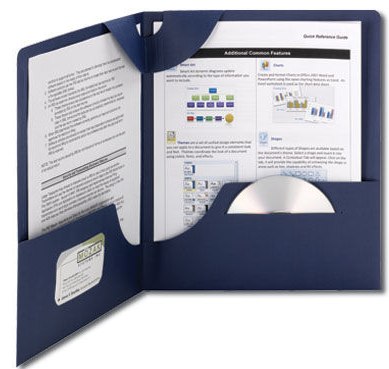
A basic two-pocket folder is just that: basic. One large piece of heavy-duty paper with the bottom edge folded up and a crease down the middle creates two pockets. Every other embellishment is gravy. (See, we’re still sticking with that meal metaphor!)
The biggest problem with two-pocket folders has always been the inability of the rough-and-tumble user to keep contents tidy. Mead’s middle-school standard-bearer, the Trapper Keeper, organizes folders by keeping the two-pockets corralled in a three-ring binder, and the pressure of the binder and other folders is usually (but not always) enough to keep errant papers from wiggling loose.
Smead’s Lockit Two-Pocket Folder works on the same basic principles, but brings something new to the table — a little loop. When raised, it makes the folder look like a prop briefcase for a third-grade production of Death of a Salesman.

When lowered, it locks the papers down! Tight!
The Lockit comes in boxes of 25 letter-size, textured (pebbled) black, blue, red and assorted color folders, as well as black, dark blue and maroon linen. Each 4 1/2″ pocket holds up to 100 sheets of paper. The pockets are die-cut; a business card fits on the left pocket, a CD or DVD on the right.
An even niftier advance is the Lockit SuperTab Two-Pocket Folder. It combines all the features of the standard Lockit with Smead’s patented SuperTab, so that when you’re done with your folder (at the end of the semester or after a project has been completed) you can label the tab and file it with traditional file folders.

As with all SuperTab products, the tabbing space is 90% larger than on standard folders, offering abundant room to label your contents. The extra-wide 1/3-cut tab is also advantageous; however, the tab is only available in the first (i.e., left) tab position, and I’d like to see Smead revisit this with tabbing at the center position, as well. The Lockit SuperTab Two-Pocket Folder is made of 11-point laminated stock, and comes in 5-packs of shiny black, blue, green and red. The pockets can accommodate 50 sheets, each.
STAND AT ATTENTION
It’s hard to be too innovative with hanging folders. Sure, we’ve looked at strengthening the hooks and firming up the rods, but there’s rarely BREAKING NEWS about hanging folders. Pendaflex has been trying to rectify that.
First, Pendaflex came out with the Ready-Tab Reinforced Hanging Folders. With these, instead of plastic inserts, the folders came with little tabs, in five positions, awaiting being folded up into place.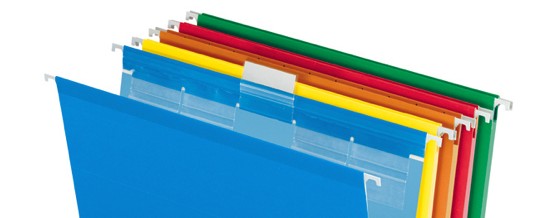
Should you choose to change placement, just fold the tab down and lift another tab upward. The durable polylaminate strips reinforce the top edges and the bottom fold, making it extra-sturdy for repeated use, and the boxes of 20 or 25 (depending on color selection — available in standard green, assorted, blue, red, yellow, violet, bright green or pink), all include a printer-ready insert sheet for labeling.
This year, Pendaflex added a new variation: the breathlessly-titled Ready-Tab Extra-Capacity Hanging Folders with Lift Tab™ Technology! The 2″ capacity letter-sized folders, available in standard green and a narrow assortment of colors, makes use of the stuffed-crust pizza metaphor for positioning tabs. Sturdy plastic-coated write-on/erase-off tabs (yes, you can erase pen marks) are tucked away inside the wrapping of the hanging rods. Just select one of five positions and pull upward on the tab. Change your mind, press it back into the pizza crust (I mean, hanging folder) and select a new tab.
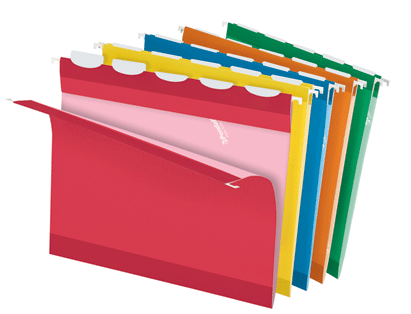
AT EASE — WITH DESSERT
Man cannot live by bread (or meat and potatoes) alone. Paper supplies, particularly for filing, are the functional main course of organizing products, but just because something is useful doesn’t mean it can’t be yummy. That’s the belief, at least, of the enterprising women who shared some gorgeous wares at this year’s NAPO Expo.
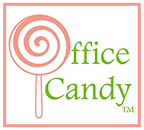
Office Candy, a distribution company started by professional organizers Laurie Noelle Meek and Beth Schlatter,
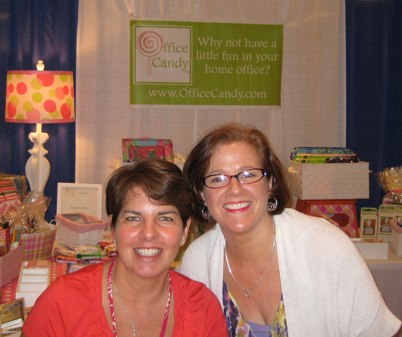
asks, Why not have a little fun in your home office? Why not, indeed?

Office Candy has gathered a delightful collection of colorful, appealing organizing tools, from file folders and notebooks to clipboards and gadget holders. It’s a one-stop shop for pretty. The theory is simple — if you’re working with attractive tools, you’ll be more inclined to use them to their greatest benefit.
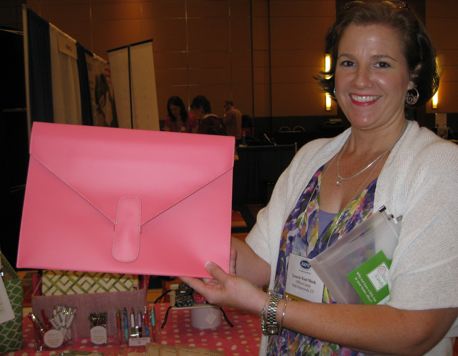
Office Candy carries some favorite brands, including Knock, Knock and Gallison, and has introduced Paper Doll to some new charms, including folders from Lady Jayne (seen below) and Cavallini.

The gals at Office Candy stock the classy Jamie Raquel mobile file totes I reviewed last year, as well as a variety of other fun, new products, like these Lilly Pulitzer notebooks.
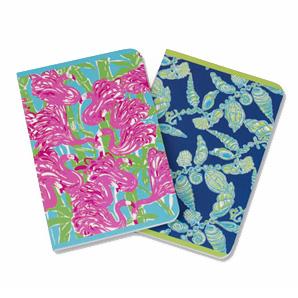
Win the paper clutter war. Taste the rainbow.




Follow Me